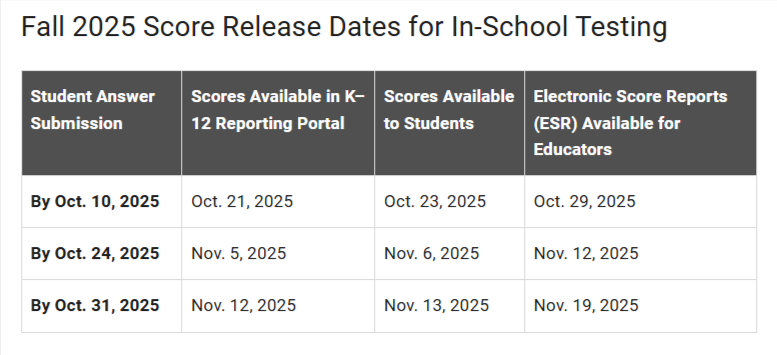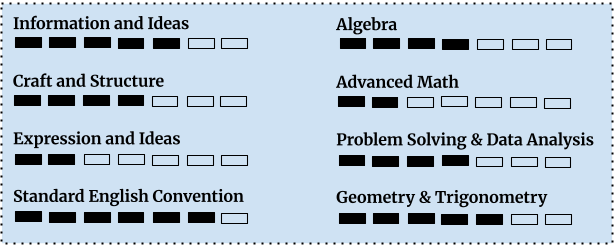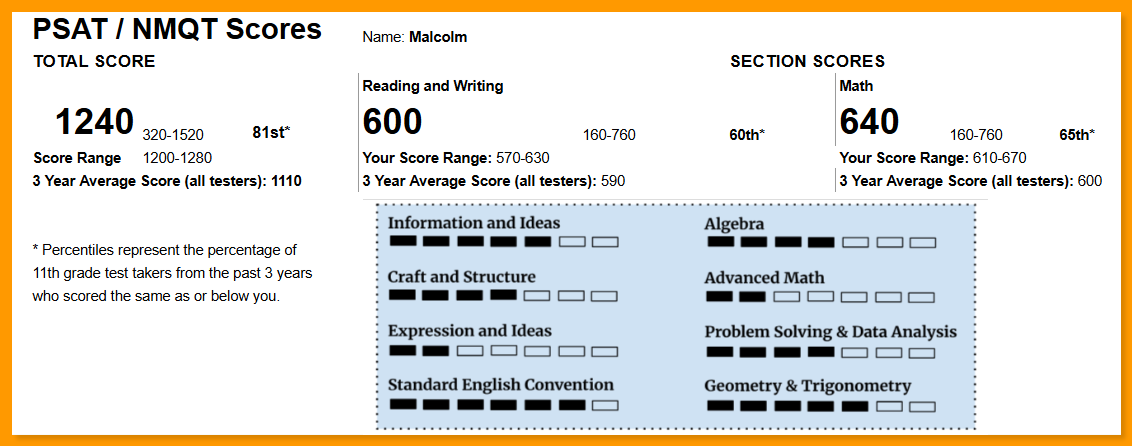




Key Takeaways
The PSAT score report not only shows the student’s current performance but also strongly indicates their likely score in the actual SAT. That way, it becomes a kind of a beacon for the students' SAT prep journey.
It uncovers the areas the student is good - or bad - at, which will help the student make a better decision about their careers. That way, tutors and counselors can see a lot more than what’s on the PSAT score report.
In this article, we will see what all things figure on the PSAT score report, discuss the score ranges, and the benchmarks. We’ll also look at how to use the score card, how to spot the student’s strengths and weaknesses based on the scores, and what mistakes to avoid. But first, we’ll talk about how and when the students can get their PSAT scores.
When do PSAT scores come out and how to get yours
The College Board says they make available the PSAT/NMSQT scores approximately four to six weeks after the test dates. However, they may be available online earlier - typically accessible between two and four weeks after the test dates. For instance, for answers submitted by October 24, 2025, the scores are available on the K-12 portal by November 5, 2025, to the students by November 6, 2025, and the ESR (Electronic Score Reports) are available to educators by November 12, 2025.

As a tutor,you want to let parents and students know these dates, so that they can access the scores in time too.
How to access PSAT reports via College Board account
Your students may access their PSAT/NMSQT, PSAT 10, or PSAT 8/9 scores in two different ways:
- School or Counselor: The student’s school or your counselor can get you a copy of your PSAT score report.
- BigFuture® School mobile app: If the student submits their mobile number on the test day, the College Board will text them once the scores are ready for access. The message will also contain information on how to download the BigFuture® School mobile app.
What’s on the PSAT score report
There are two sections on the PSAT: Reading and Writing (RW), and Math (M). The report card mentions scores of each of these two sections as well as the total score of the entire test. The total score is simply the addition of the two sectional scores.
Total score
The total score is a three-digit number that falls between 320 and 1,520 points.
The PSATmaintains what is called a common score scale (or continuous score scale) with the SAT. That means whatever a student scores on the PSAT for a particular section is an accurate representation of their likely score on the actual SAT, had they taken the SAT on that particular day.
For example, if Malcolm scored 480 in Reading and Writing (RW) in the PSAT, he would have scored 480 in Reading and Writing (RW) on the SAT, had he taken the SAT on the same day.
The common score scale also accepts growth the same way. If Malcolm scored 480 in RW on the PSAT/NMSQT last year and scores 540 in the RW on the SAT this year, his score is said to have grown by 60 points.
Section scores
Each section has a score range of 160 to 760 points. Within the Evidence-Based Reading & Writing (RW) section, the PSAT evaluates four domains. The skills tested and their percentage distribution is shown in the adjoining table:
Similarly, within the Math section, the PSAT evaluates four domains. The topics tested and their percentage distribution is shown in the adjoining table:
PSAT-reading-and-writing-domains
The four domains and their weight in PSAT Reading and Writing
Similarly, within the Math section, the PSAT evaluates four domains. The topics tested and their percentage distribution is shown in the adjoining table:
PSAT-math-domains
The four domains and their weight in PSAT Math section
For instance, in the adjoining screenshot, the student has performed better under Information and Ideas as compared to Craft and Structure. The same student has performed the best in Geometry & Trigonometry in the Math section, but the least in Advanced Math.

The domain-wise performance is a great way of understanding what areas the student is good at and - more importantly - what areas do they need additional practice.
In the image showing domain-wise performance, you would have noticed Malcolm has performed his lowest in Expression and Ideas. That means when he begins his SAT preparations, he will need to pay more attention to questions of these type.
Benchmarks
The PSAT sectional scores don’t just measure the competence of the student across domains, they go a step further. It sets a threshold which shows the extent to which the student is ready for college in due course.
Both the sections have individual thresholds called PSAT benchmarks. This benchmark is nothing but a score.
The PSAT Benchmarks
PSAT-benchmarks
PSAT Benchmarks for Grade 10 and 11
So how do you interpret these benchmarks?
Let us say Maya, a Grade 10 student, scored 440 in R&W and 460 points in Math in the PSAT. It’s obvious that her score for R&W is above the benchmark but her Math score is below the benchmark.
So if Maya were to continue her current efforts, she’d be college-ready with R&W skills when she takes the actual SAT. However, because she failed to clear the Math benchmark, her current effort won’t suffice and she’ll need extra work in order to be college-ready.
Educators, parents, and students can use these benchmarks to identify specific challenges and create personalized study plans. If a student hasn’t cleared the benchmarks, the study plan will help ensure they at least reach the cutoff. If, on the other hand, the student has met or exceeded the benchmark, the study plan can make further improvements.
Additional information
Understanding the PSAT score report
Several other things appear on the PSAT score report, so it’s important that you, as a tutor, can explain how to read the PSAT score report to the parents in detail. Here are the key features:
Score ranges
The College Board believes that “a student’s ability is better represented by score ranges than points”.
Just below each of the sectional scores and the total scores, you’ll see something called a Score Range. For instance, the PSAT score report of a student whose R&W score is 620 might show a score range 590-650 for that section. It means the student’s score would have fallen between 590 and 650, had the student taken the SAT under a different administration.
These ranges are a reflection of the deviation or standard error of measurement of the test, according to the testing authorities.
3-Year average
In addition to the Score Range, you’ll also see the 3-year average for each section as well as the total score. As the name suggests, it is the average score achieved by all those who took the test in the past three years. Remember the average scores are across all grades.
This average is a good indicator of how students have performed over the past three years. You can use this to give a reality check to your students if they are feeling too low or excessively confident.
Understanding the percentiles on the report
In addition to the scores, the PSAT provides you what is known as a percentile score. It is a better indicator of the student’s performance as compared to the rest of the test-takers. Let’s examine it.
PSAT percentiles explained
The percentile score of a student is the percentage of test-takers that scored equal to or less than the student.
It will be easier to understand this with the help of an example. Look at the score card in the adjoining image. You will notice that next to the total score of 1,240, there’s a number “81st”. This means that out of all the students that took the PSAT in the past three years, 81 percent of the total test-takers scored equal to or less than 1,240.
You will notice similar numbers with R&W sectional scores (60th) and Math sectional scores (65th).

Put differently, out of every 100 test-takers, 81 students scored equal to or below than Malcolm. For the R&W section, this number was 60, while for Math this number was 65.
Difference between percentiles and raw score
The two are significantly different. Percentiles represent comparative performance while raw score simply stands for the number of correct answers and is an absolute performance.
Percentiles can only be arrived at by knowing the performance of all the students who took the test. Raw score, on the other hand, needs no such information. That means percentiles represent the performance of a particular student as compared to the entire group of test-takers and is a great indicator of how well (or how poorly) the student performed.
Let us consider a hypothetical case. Imagine that the next October, the testing authorities make the R&W section exceptionally challenging. As a result, Malcolm’s raw score is just 10. However, everybody who takes the PSAT finds it equally difficult and everyone receives a low raw score.
Since everyone received a low raw score, the performance of Malcolm, relative to the rest of the test-takers doesn’t change. So he will still get a high percentile score.
On the whole, percentiles are a strong indicator of a student’s performance among all the test-takers, but the raw score isn’t.
National percentiles vs Benchmarks
Percentiles and benchmarks are important indicators of how the student has performed, but they mean different things.
As we just mentioned, percentiles represent a student’s performance vis-a-vis that of the rest of the students. Percentile shows the student’s standing among other students, but doesn’t directly relate to anything else.
Benchmark, on the other hand, is a standard of college-readiness. If the student’s score equals or exceeds the benchmark, it means that the student is on track in skilling themselves for the requirements of a college. Hence, PSAT benchmarks are an academic indicator.
Tutor note
Parents may need a detailed explanation about what percentiles mean. Firstly, explain that bigger the number, better the performance of the student. Next, tell them it’s a way to show the student’s test result on a scale of hundred. Finally, clarify that if there were only 100 students in the PSAT, the percentiles would show how many students are behind the student in terms of scores.
A converse, but less common, way of explaining is this: deduct the percentiles from 100 and the result you get is the rank of the student out of every 100. In the example we mentioned earlier, Malcolm scored 81 percentile. Deducting 81 from 100 gives 19, which suggests that out of 100 test-takers, Malcolm stood at the 19th position from the top.
How students and tutors can use PSAT scores
Once you know what’s on the PSAT score report, it’s important to know how to use those numbers. Here’s how your pupils and you can use the scores:
For students
In a year or two after taking the PSAT, your students will be writing the SAT. There are five ways students can use the PSAT scores:
- Identify strengths and weaknesses: The scores are like an X-ray; they expose where the student lacks and where they shine. This will guide their SAT prep.
- Set realistic goals: The PSAT score details show where the student currently is. This helps students set realistic goals.
- Create study plans: Once the student knows where they are and what they’d like to score in the actual SAT, they can create realistic study plans.
- Compare progress: Have students take period practice tests to see if they are doing better and if their progress rate is adequate to meet their goals.
- Explore career choices: Strengths in a particular section can suggest what are the likely careers best suited to the student’s skills and preferences. They can use the scores to speak with counselors and learn more.
For tutors
The digital PSAT score report is a great tool for tutors to shape their students’ SAT prep journey. Here’s how:
- Diagnose students’ performance: You will immediately spot what areas the student needs the most help with. Use it to counsel, guide, and train your students.
- Tailor lesson plans: You can use the score card to create personalized SAT prep plans for your students.
- Adjust strategies: What works for a 80-percentiler may not work well for a 60-percentiler. You can use the scores to speed up, stress, or skim domains because that’s what your students will benefit the most from.
- Recommend resources: Your student needs not more but better, optimized resources as they move from PSAT to SAT. Prediction about their scores will be more accurate when you point your students towards the right SAT prep resources.
- Remind students to work hard: PSAT scores are a good indicator of, but not a guarantee for a great SAT score. Make sure you emphasize the importance of hard work so that your students don’t lose focus.
Digital PSAT score report updates
Because of its digital nature, the PSAT test (and the scores) reveal a great deal more than simply numbers.
Here are the three key things that stand out with the digital version and reporting
- Adaptive nature: Because of the adaptive nature of the test, the difficulty level of the second module in each section depends on how the student performed in the first. That means the scores don’t directly show the number of correct answers but instead reflect the difficulty level of the questions answers.
- Unequal scoring: Not all questions weigh equal. If the student has done well in the base module, their adaptive module will have mostly difficult questions. Because the PSAT score takes into account all this, all questions do not carry an equal weight.
- Strategic performance: Doing well in the base module also suggests the student could optimize their performance and thus receive a better score. This cannot be evaluated in a traditional paper-and-pencil version.
Common mistakes to avoid
It’s not unusual for students and parents to misinterpret the PSAT scores. That’s where you, as a seasoned tutor, can step in and help them avoid the common mistakes.
- Confusing percentiles with percentages: It’s important that students and parents understand percentiles are not percentages. Getting, say, 80 percentiles, isn’t the same as getting 80 percent of the answers correct.
- Misunderstanding key pointers: It must be clearly understood that benchmarks or a PSAT to SAT prediction, while very important, are pointers and not guarantees. Be sure to stress the fact to students and parents that it will be important to continue planning, working hard, and taking practice SATs regularly as planned.
- Underusing insights: The sectional scores, and their respective domain performance indicators, are a great way to plan the SAT prep journey, target colleges, and explore career options. The more you use these insights, the higher your students can score.
Conclusion and key takeaways
In many ways, the PSAT score report reflects what Bernardo Villalobos, the choir director in the Oscar-winning movie CODA (2021) says,”I can't do my job unless you do yours”. The score is a strong indicator of the future SAT scores, but there’s a lot of work involved on the way.
Students need to treat the scores as a tool to build the roadmap for the test prep journey. A committed tutor, with the help of a powerful digital platform, can transform the lives of disciplined students by leveraging score insights.
As the top choice of tutors and over 14,000 students, EdisonOS can scale and transform the way how students navigate from PSAT to SAT. Why not speak to one of the experts at EdisonOS to learn more?


Tutors Edge by EdisonOS
in our newsletter, curated to help tutors stay ahead!
Tutors Edge by EdisonOS
Get Exclusive test insights and updates in our newsletter, curated to help tutors stay ahead!
Recommended Reads
Recommended Podcasts




.png)





.png)
.webp)
